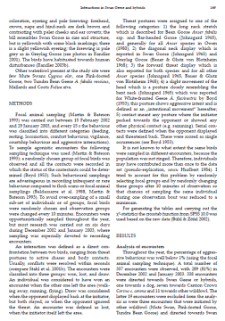- Search in all Repository
- Literature and maps
- Archeology
- Mills database
- Natural sciences
Advanced search
Advanced search
Advanced search
Advanced search
Advanced search

Object
Title: Faecal Escherichia coli and Chlamydophila psittaci in the superb lyrebird Menura novaehollandiae: host sex and age effects
Creator:
Milne, Rebecca J ; Polska Akademia Nauk. Muzeum i Instytut Zoologii
Date issued/created:
Resource type:
Subtitle:
Acta Ornithologica, vol. 39, no. 2 ; Wpływ wieku i płci na zarażenie bakteriami Escherichia coli i Chlamydophila psittaci u lirogona wspaniałego ; Faecal microbes of lyrebirds
Contributor:
Museum and Institute of Zoology, Polish Academy of Sciences
Publisher:
Place of publishing:
Description:
Bibliogr. s. 119-120 ; S. [111]-120 : il. ; 27 cm ; Streszcz. pol. Nazwy taksonów także w jęz. łac.
Type of object:
Abstract:
The Superb Lyrebird is a sexually dimorphic passerine that although is not considered endangered, it has been declining in population size since the 1940s due primarily to urban development. Recent reports suggest that lyrebirds may be threatened by chlamydial infection. We studied levels of faecal infection by two microparasites in lyrebirds: Chlamydophila psittaci and Escherichia coli in the Sherbrooke Forest, south-eastern Australia. Fresh faecal samples were obtained from 33 lyrebirds (15 adult females, 13 adult males and 5 juveniles) — estimated of 27.5% of the population, all of them tested negative to Ch. psittaci. E. coli prevalence was compared between adult males and females and no difference was found. This result is expected, for instance, if E. coli is sexually transmitted and lyrebirds are promiscuous. Trends for juveniles to be more parasitized than adults were detected, but they were statistically not significant. Behavioural analyses of video footage indicate that E. coli infected birds did not allocate more or less time to any of the activities considered than did non infected birds. This might suggest that E. coli infection in lyrebirds is relatively benign, and behavioural effects may thus be subtle. No significant differences were found in specific measurements of foraging behaviour but non infected birds tended to scratch more frequently than infected birds.
Relation:
Volume:
Issue:
Start page:
End page:
Detailed Resource Type:
Format:
Resource Identifier:
oai:rcin.org.pl:55517 ; click here to follow the link
Source:
MiIZ PAN, sygn. patrz sygn. czas. P.257-39-2 ; MiIZ PAN, sygn. patrz sygn. czas. P.4568-39-2 ; click here to follow the link
Language:
Rights:
Prawa zastrzeżone - dostęp nieograniczony
Terms of use:
Digitizing institution:
Muzeum i Instytut Zoologii Polskiej Akademii Nauk
Original in:
Biblioteka Muzeum i Instytutu Zoologii PAN
Access:
Object collections:
- Digital Repository of Scientific Institutes > Partners' collections > Museum and Institute of Zoology PAS > Scientific Journals
- Digital Repository of Scientific Institutes > Partners' collections > Museum and Institute of Zoology PAS > MIZ PAN Publications > Acta Ornithologica
- Digital Repository of Scientific Institutes > Literature > Journals/Articles
Last modified:
Oct 2, 2020
In our library since:
Jul 28, 2015
Number of object content downloads / hits:
45
All available object's versions:
https://rcin.org.pl./publication/49781
Show description in RDF format:
Show description in RDFa format:
Show description in OAI-PMH format:
Objects Similar
Chróst, Ryszard J.
Dmowska, Ewa

 INSTYTUT ARCHEOLOGII I ETNOLOGII POLSKIEJ AKADEMII NAUK
INSTYTUT ARCHEOLOGII I ETNOLOGII POLSKIEJ AKADEMII NAUK
 INSTYTUT BADAŃ LITERACKICH POLSKIEJ AKADEMII NAUK
INSTYTUT BADAŃ LITERACKICH POLSKIEJ AKADEMII NAUK
 INSTYTUT BADAWCZY LEŚNICTWA
INSTYTUT BADAWCZY LEŚNICTWA
 INSTYTUT BIOLOGII DOŚWIADCZALNEJ IM. MARCELEGO NENCKIEGO POLSKIEJ AKADEMII NAUK
INSTYTUT BIOLOGII DOŚWIADCZALNEJ IM. MARCELEGO NENCKIEGO POLSKIEJ AKADEMII NAUK
 INSTYTUT BIOLOGII SSAKÓW POLSKIEJ AKADEMII NAUK
INSTYTUT BIOLOGII SSAKÓW POLSKIEJ AKADEMII NAUK
 INSTYTUT CHEMII FIZYCZNEJ PAN
INSTYTUT CHEMII FIZYCZNEJ PAN
 INSTYTUT CHEMII ORGANICZNEJ PAN
INSTYTUT CHEMII ORGANICZNEJ PAN
 INSTYTUT FILOZOFII I SOCJOLOGII PAN
INSTYTUT FILOZOFII I SOCJOLOGII PAN
 INSTYTUT GEOGRAFII I PRZESTRZENNEGO ZAGOSPODAROWANIA PAN
INSTYTUT GEOGRAFII I PRZESTRZENNEGO ZAGOSPODAROWANIA PAN
 INSTYTUT HISTORII im. TADEUSZA MANTEUFFLA POLSKIEJ AKADEMII NAUK
INSTYTUT HISTORII im. TADEUSZA MANTEUFFLA POLSKIEJ AKADEMII NAUK
 INSTYTUT JĘZYKA POLSKIEGO POLSKIEJ AKADEMII NAUK
INSTYTUT JĘZYKA POLSKIEGO POLSKIEJ AKADEMII NAUK
 INSTYTUT MATEMATYCZNY PAN
INSTYTUT MATEMATYCZNY PAN
 INSTYTUT MEDYCYNY DOŚWIADCZALNEJ I KLINICZNEJ IM.MIROSŁAWA MOSSAKOWSKIEGO POLSKIEJ AKADEMII NAUK
INSTYTUT MEDYCYNY DOŚWIADCZALNEJ I KLINICZNEJ IM.MIROSŁAWA MOSSAKOWSKIEGO POLSKIEJ AKADEMII NAUK
 INSTYTUT PODSTAWOWYCH PROBLEMÓW TECHNIKI PAN
INSTYTUT PODSTAWOWYCH PROBLEMÓW TECHNIKI PAN
 INSTYTUT SLAWISTYKI PAN
INSTYTUT SLAWISTYKI PAN
 SIEĆ BADAWCZA ŁUKASIEWICZ - INSTYTUT TECHNOLOGII MATERIAŁÓW ELEKTRONICZNYCH
SIEĆ BADAWCZA ŁUKASIEWICZ - INSTYTUT TECHNOLOGII MATERIAŁÓW ELEKTRONICZNYCH
 MUZEUM I INSTYTUT ZOOLOGII POLSKIEJ AKADEMII NAUK
MUZEUM I INSTYTUT ZOOLOGII POLSKIEJ AKADEMII NAUK
 INSTYTUT BADAŃ SYSTEMOWYCH PAN
INSTYTUT BADAŃ SYSTEMOWYCH PAN
 INSTYTUT BOTANIKI IM. WŁADYSŁAWA SZAFERA POLSKIEJ AKADEMII NAUK
INSTYTUT BOTANIKI IM. WŁADYSŁAWA SZAFERA POLSKIEJ AKADEMII NAUK


































